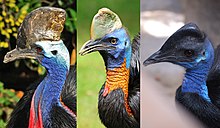
Back شبنم Arabic شبنم ARZ Casuarius AST Narkoyum (Casuarius) AVK Kazuar Azerbaijani Kasuari BAN Казуары Byelorussian Soari BEW Казуари Bulgarian Kazoar Breton
| Cassowary Temporal range: Early Pliocene – Recent
| |
|---|---|

| |
| Montage of three species; left to right: southern cassowary, northern cassowary and dwarf cassowary | |
| Scientific classification | |
| Domain: | Eukaryota |
| Kingdom: | Animalia |
| Phylum: | Chordata |
| Class: | Aves |
| Infraclass: | Palaeognathae |
| Order: | Casuariiformes |
| Family: | Casuariidae Kaup, 1847[1] |
| Genus: | Casuarius Brisson, 1760 |
| Type species | |
| Struthio casuarius[2] | |
| Species | |
| |
| Synonyms | |
Cassowaries (Indonesian: kasuari, Biak: man suar 'bird strong',[4][5] Tok Pisin: muruk, Papuan:[citation needed] kasu weri 'horned head'[6] ) are flightless birds of the genus Casuarius in the order Casuariiformes. They are classified as ratites: flightless birds without a keel on their sternum bones. Cassowaries are native to the tropical forests of New Guinea (Western New Guinea and Papua New Guinea), The Moluccas (Seram and Aru Islands), and northeastern Australia.[7]
Three cassowary species are extant. The most common, the southern cassowary,[8] is the third-tallest and second-heaviest living bird, smaller only than the ostrich and emu. The other two species are represented by the northern cassowary and the dwarf cassowary; the northern cassowary is the most recently discovered and the most threatened.[8] A fourth but extinct species is represented by the pygmy cassowary.
Around 90% of the cassowary diet consists of fruit, although all species are opportunistic omnivores, and take a range of other plant foods, including shoots and grass seeds, in addition to fungi, eggs, invertebrates, carrion, and small vertebrates like fish, rodents, small birds, frogs, lizards, and snakes.[9] Although all ratites can eat meat, cassowaries, by definition, are the most omnivorous and predatory, owing to having the smallest and least herbivorous gastrointestinal tract out of any ratites (akin to true omnivores),[10] as well as the fact that they are one of the only two ratites with a recorded hunting behaviour that is not mere foraging.[11] Therefore, despite being considered an obligate frugivore, cassowaries consume a considerable amount of protein throughout their life stages, and throughout the year.[12] Hence, cassowaries are the largest fruit-eating bird, the largest omnivorous bird and the largest opportunistically predatory avian.[13][14]
Cassowaries are very wary of humans, but if provoked, they are capable of inflicting serious, even fatal, injuries. They are known to attack both dogs and people. The cassowary has often been labelled "the world's most dangerous bird",[8][15] although in terms of recorded statistics, it pales in comparison to the common ostrich, which is recorded to kill two to three humans per year in South Africa.[16]
- ^ Melville, R. V.; Smith, J. D. D., eds. (1987). Official Lists and Indexes of Names and Works in Zoology. ICZN. p. 17.
- ^ "Cassuaridae". aviansystematics.org. The Trust for Avian Systematics. Retrieved August 5, 2023.
- ^ "Part 7 - Vertebrates". Collection of group names. 2007. Archived from the original on October 5, 2016. Retrieved May 4, 2016.
- ^ F.J.F. Van Hasselt (1947). Noemfoorsch Woordenboek (in Dutch). J.H. De Bussy. p. 146.
- ^ Soeparno (1977). Kamus Bahasa Biak-Indonesia (in Indonesian). Departemen Kebudayaan dan Pendidikan. pp. 39, 71.
- ^ "Interesting facts about Cassowaries". Heritage Lodge. 2021.
- ^ Clements (2007).
- ^ a b c "Cassowary". San Diego Zoo Wildlife Alliance. 2022. Retrieved September 18, 2022.
- ^ "What Do Cassowaries Eat? (Full Diet, Habits and Behavior)". Birdfact. 2022.
- ^ Cite error: The named reference
cassowariesandkakaposwas invoked but never defined (see the help page). - ^ Cite error: The named reference
australiangeographicwas invoked but never defined (see the help page). - ^ Cite error: The named reference
cairnswas invoked but never defined (see the help page). - ^ Boettcher, James (June 12, 2018). "Species Feature: Southern Cassowary". Australian Wildlife Journeys.
- ^ "What Do Cassowaries Eat?". AZ Animals. 2022.
- ^ Mosbergen, Dominique (April 14, 2019). "'World's Most Dangerous Bird' Kills 75-Year-Old Owner In Florida". HuffPost. Retrieved April 15, 2019.
- ^ Usurelu, Sergiu; Bettencourt, Vanessa; Melo, Gina (2015). "Abdominal trauma by ostrich". Annals of Medicine & Surgery. 4 (1): 41–43. doi:10.1016/j.amsu.2014.12.004. PMC 4323753. PMID 25685344.